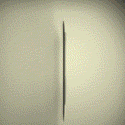
Once upon a time, before playlists and streaming services ruled the world, the album cover was more than just packaging—it was a bold visual statement, a portal into the artist’s mind, and, for many fans, the first clue to the sonic madness waiting inside. Album art could be psychedelic, political, sensual, strange—or all of the above—and no group embodied that better than the intergalactic architects of funk: Parliament-Funkadelic.
Before Outkast, before Prince, before Kendrick ever dared to get cosmic, there was George Clinton—one of music’s greatest shape-shifters and the founding father of the P-Funk universe.
Clinton got his start in the 1950s as a doo-wop singer with his group The Parliaments, cutting his teeth in New Jersey barber shops and Motown hopeful circles. But the ‘70s is where he changed the game completely. Frustrated by legal issues and the limitations of soul music, Clinton split his musical persona into two bands: Parliament, which leaned into horn-heavy, radio-friendly funk, and Funkadelic, a guitar-driven, psychedelic force that fused rock, funk, gospel, and acid-soaked philosophy. Together, they became Parliament-Funkadelic, or simply: P-Funk.
The P-Funk collective grew into a sprawling, multiverse of characters and sounds—Bootsy Collins on bass, Bernie Worrell on keys, Garry Shider in a diaper, and Clinton himself as a space prophet descending from the Mothership to “free your mind… and your ass will follow.”
With wild stage shows, otherworldly fashion, and some of the most innovative music of the 20th century, Clinton and his crew didn’t just create albums—they created mythology. Parliament albums were concept records full of sci-fi plots, while Funkadelic’s were more raw and political. And together, they made the kind of music that makes your body move while your brain levitates.
By the end of the 1970s, they had redefined what funk could be—and helped lay the foundation for hip-hop, electronic music, and Afrofuturism.
Led by the brilliant and bizarre George Clinton, P-Funk didn’t just make music—they built an entire universe. And the album covers? They were blueprints. Illustrated with wild sci-fi scenes, cartoon chaos, cosmic mythology, and unapologetic Black surrealism, their artwork is just as iconic as their basslines.
So to launch our new series celebrating the forgotten art of album covers, we’re traveling aboard the Mothership to count down the 10 greatest Parliament-Funkadelic covers ever pressed to vinyl. Buckle up, earthlings:
The 10 Best Parliament Album Covers: A Funkadelic Feast for the Eyes
Funkadelic – Maggot Brain (1971)

Arguably the most haunting album cover ever. A woman’s head (model Barbara Cheeseborough) screams from a pit of dirt—raw, emotional, unforgettable. It’s as striking as Eddie Hazel’s epic title track.
Mothership Connection (1975)

This is the iconic Parliament cover. A cosmic George Clinton riding a UFO through deep space? Yes, please. This artwork defines the P-Funk aesthetic—Afrofuturistic, outrageous, and unapologetically cool.
Funkentelechy vs. the Placebo Syndrome (1977)

A full-blown comic book-style cover complete with the villainous Sir Nose D’Voidoffunk. Designed by Overton Loyd, this one gave fans a visual mythology to match the music’s psychedelic funk odyssey.
The Clones of Dr. Funkenstein (1976)

Clinton as a mad scientist? You bet. This cover turns the funk into a genetic experiment, with vintage sci-fi flair and plenty of camp. Science fiction never looked so funky.
Gloryhallastoopid (1979)

A visual explosion of pyramids, UFOs, and funk gods—this one doubled down on the group’s Afrofuturist visuals. Plus, the typography alone is a trip.
Funkadelic – Uncle Jam Wants You (1979)

It was a direct parody of military propaganda posters, with Clinton posing as a funked-out revolutionary. The cover art screams “join the army of funk,” and honestly, who could resist?
Motor Booty Affair (1978)

Parliament goes underwater! A lavishly illustrated Atlantis of funk, featuring mer-funkateers, aquatic afros, and more fishy puns than you can shake a seaweed strand at. Fun fact: the vinyl included cut-out cardboard characters.
Trombipulation (1980)

One of the trippiest covers in the Parliament catalog, this one features an eerie, brainy alien-creature face with a horned mustache. It’s the stuff of sci-fi dreams—or nightmares—depending on how hard you’re grooving.
Funkadelic – One Nation Under a Groove (1978)

A cover so joyful, it practically dances out of the sleeve. Pedro Bell once again nails the funky utopia vibe. It’s a visual celebration of community, unity, and endless groove.
Chocolate City (1975)

A politically charged classic that visualizes Washington, D.C. as a Black utopia. The cover design feels grounded compared to later albums, but its message and aesthetic are just as powerful.
So whether you’re grooving to a vinyl spin of Mothership Connection or just admiring the psychedelic madness of Uncle Jam Wants You on your screen, remember: these covers weren’t just album art—they were declarations of a funk revolution. Parliament-Funkadelic didn’t just bring the noise, they brought the visuals to match.
In an era where streaming rules and album sleeves gather dust, these covers remind us that music isn’t just something you hear—it’s something you see, feel, and ride into the cosmos on a glittering spaceship made of funk. All aboard the Mothership. Next stop: the outer limits of imagination.
REELated:
Doechii makes history at 67th annual Grammy Awards











